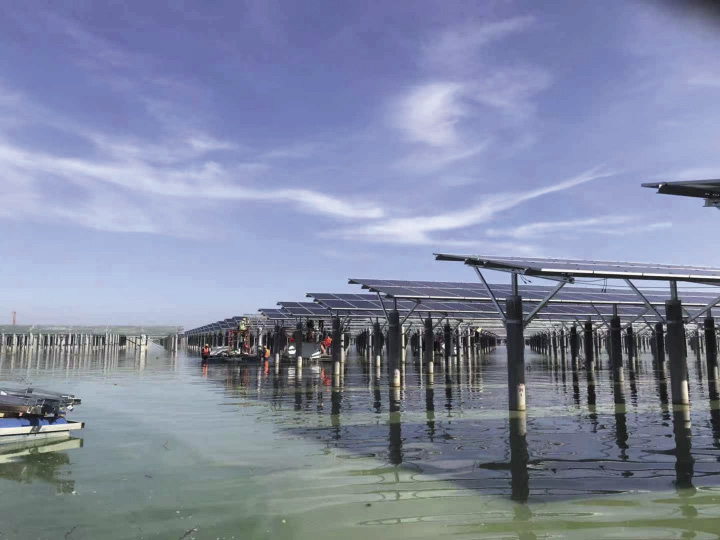The smarter E Award judges were also clearly impressed by the Dau Tieng installation in Vietnam, as it was a finalist in the “outstanding projects” category earlier this year. Vietnamese developer Xuan Cau teamed up with Bangkok-based B.Grimm Power to invest about VND 9,100 billion ($392.5 million) in the unique, three-stage solar plant. PowerChina Huadong handled EPC duties at the site – including the installation of a steel platform for the 220 kV substation and inverters – roughly 120 kilometers outside of Ho Chi Minh City in Tay Ninh province, next to the Cambodian border.
The first two phases of the site were selling power to state-owned utility Electricity of Vietnam (EVN) by June 2019. The project’s third phase is now in development, with JinkoSolar supplying the 330 W multicrystalline PV modules. Xuan Cau and B.Grimm have not revealed the supplier of the 1,500 V central inverters. But the most interesting aspect of this installation is the challenge posed by the project site – the vast Dau Tieng Reservoir – and how the developers overcame these obstacles.
Sign of the times
To be clear, Dau Tieng is not necessarily a sign of what’s to come in the short term. Vietnam’s nascent solar market exploded last year, with the International Renewable Energy Agency (IRENA) estimating the country’s cumulative installed PV capacity at roughly 5.7 GW by the end of December 2019, from just a little more than 100 MW a year earlier.
But Minh Khoi Le, a research analyst for Rystad Energy, says that he does not expect “massive growth” in the year ahead. The “next phase of the policy will be auctions,” he explains, and it will be a bit slow at first. He expects just 200-500 MW of large-scale solar to be installed in 2021.
But based on Vietnam’s current power development plan, the government aims to install around 4 GW of solar capacity by 2025, and 12 GW by 2030. In other words, momentum will start to build again in the medium term. “Moving forward, we can start to see gigawatt size happen again,” Minh explains.
So while Dau Tieng is not necessarily a sign of what to expect in the next 12 months, it certainly shows what’s possible in Vietnamese solar – and serves as a striking reminder of the nation’s explosive burst of deployment in 2019.
As Berg explains, the Dau Tieng project shows what ambitious developers can pull off, even at extremely challenging project sites. “The cost involved makes such complex projects difficult to achieve without attractive incentives, as in the case of Vietnam’s feed-in tariff,” she adds.
Wild fluctuations
What makes the Dau Tieng project truly interesting is the structures upon which the panels are mounted. Arctech Solar supplied unique concrete pillars, which were used because the reservoir’s water levels fluctuate wildly throughout the year. As Minh explains, a “floating structure wouldn’t work.” PowerChina Huadong mounted the PV modules on the pillars, ranging from 2.5 meters to 8 meters in height. It used zinc brackets on the tops of the pillars to support the panels, and planted the structures in the lake bed.

Berg notes that IHS Markit does not consider the Dau Tieng project to be a floating PV array because of the use of concrete piles. “In Vietnam, land use has been one of the limitations for the construction of large PV plants,” she says. “Developers are now looking at alternative sites, such as water bodies, to enable further deployment.”
Xuan Cau has highlighted some of the challenges that the site presented. The construction company noted difficulties in building the platform for the substation and inverters, and the need to use a special vessel to install the concrete pillars. It also encountered local supply shortages with the six different types of pillars it used. And it said that the reservoir’s fluctuating water levels complicated the installation of the piles.
Rystad Energy’s Minh says the project underscores how foreign companies participated in the first stage of Vietnam’s solar rollout.
“What we saw in the first phase of this FIT, the Chinese companies who were working in Vietnam were mainly under the contractor side of things,” he says, noting that Chinese players have been more dominant on the developer side in Laos and Myanmar. “But in Vietnam, it is more Thai companies coming in to invest and develop projects, rather than Chinese companies.”
The views and opinions expressed in this article are the author’s own, and do not necessarily reflect those held by pv magazine.
This content is protected by copyright and may not be reused. If you want to cooperate with us and would like to reuse some of our content, please contact: editors@pv-magazine.com.








It is really amazing to what lengths some will go to “complicate” their lives….
Vietnam has over 100,000 km2 of Agricultural Land. Just 5% of this used for AgrVoltaics can Support 750GW of Solar Panels…. why does Vietnam need these “exotic” Zinc Brackets and underwater foundations for the Arrays…. just use regular steel with AgriVoltaics…. and let the farmers “reap some benefits” too….